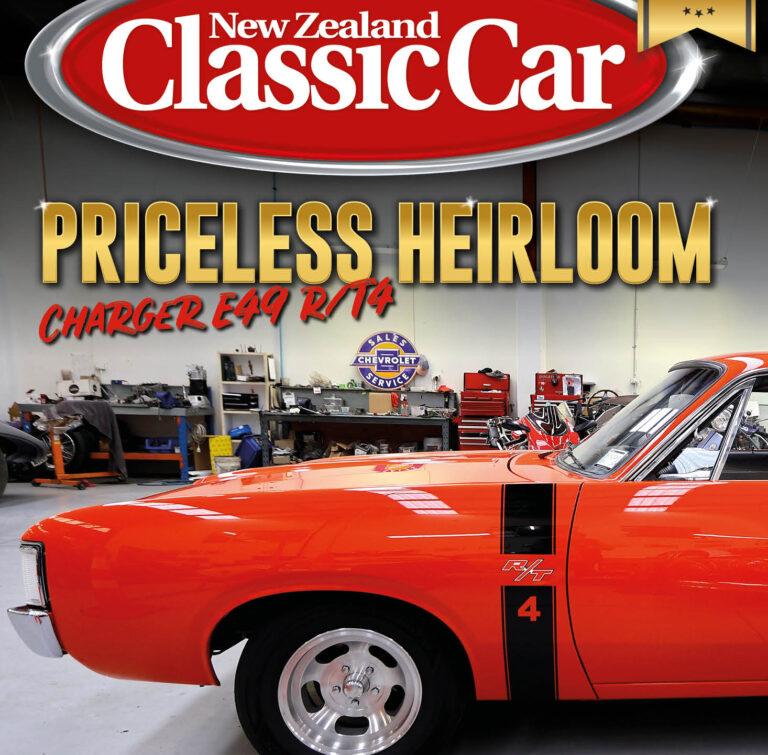Back in Issue No. 280 of New Zealand Classic Car, correspondent Chris Field wrote about his experience of being apprehended in his 1964 Rolls-Royce for displaying a UK- rather than New Zealand–made number plate. Chris also wrote to the Vintage Car Club’s magazine, Beaded Wheels, about the same experience.
“What’s the problem, officer?” asked Chris when he was pulled over — and I guess many others caught in the same situation would have asked the same question. In my opinion, there is no satisfactory reason why any properly manufactured licence plate, even if made overseas, should not be displayed as long as it contains the correct New Zealand registration number.
Prior to the advent of permanent plates in 1965, licence plates were issued every three to four years. The plates immediately prior to the black-and-silver ones were yellow and black. Back then, as far as I can recall, the issue of non–New Zealand–made plates didn’t arise. I believe the old black-and-silver plates were superseded by white-and-black plates in 1986. Between then and now, there has been a significant increase in the type of vehicle licence plates able to be affixed to your vehicle. As of today, there are eight different types of plates available:
- normal black-and-white
- fashion — with red or blue lettering, blue or black silver fern, flame, flower, rugby, or New Zealand logos
- graphic (with a picture top or bottom)
- Euro style (European style, 520x112mm, with graphic either side)
- mini Euro style (440x112mm, with graphic on either left or right)
- message (with a small message above and/or below the licence number)
- branded (such as Audi, VW, or Jaguar)
- and, of course, the older black-and-silver plates.
So, ignoring all the different types of plates save for the Euro style for the moment, there is still no logical reason why an overseas-manufactured plate that is very similar to, or exactly the same as, a currently permissible one cannot be used.
Plating up
Car dealers lobbied the NZ Transport Agency (NZTA) for approval to be able to use Euro-style plates on European cars, because the New Zealand–made plates looked stupid. An argument could also be made here that New Zealand plates of six characters look wrong on many American cars, as their number-plate apertures were designed for a smaller-width plate. When we obtained ‘59CAD’ (a personalized plate) for our 1959 Cadillac back in the late 1980s, it fitted only because it had five characters. In recent times, any car show will have many examples of American cars displaying US licence plates, the numbers on which have been personalized. What happens is that you personalize the number on the American plates, receive the New Zealand–made black-on-white plates, but affix the American ones. This is least likely to be noticed if the US plate has a white background with black numbers.
Clearly, car dealers (and quite rightly so) wanted their European vehicles to look the part, and, given they were designed for a European-style number plate, why shouldn’t New Zealand plates be made to suit? Having said that, I’m surprised no American car club to date seems to have lobbied the NZTA for similar consideration for its members’ cars.
Common sense?
Which brings me back to Chris’ grizzle. His Rolls was, and still is, a magnificent piece of prestige English motoring — albeit defiled with a mis-matched New Zealand plate. Why can’t he fit a UK-made number plate that contains his New Zealand registration number?
Picture this: hypothetically, Chris gets snapped by one of those pesky speed cameras. What is important is that his vehicle can be identified from the licence plate. If his number is (for example) ‘CF1234’, then, as long as his details come up when that number is fed into the confidential database, what’s the problem?
While I think Chris may have employed a bit of editorial licence when he claimed to have seen “several E-Type Jags” on the day with illegal front number plates, his point is nevertheless valid. For instance, on page 31 of NZ Classic Car (No. 279), there are pictures of two New Zealand–registered E-Types with supposedly illegal front plates. There is yet another example on page 87 of that same issue. Now, the common sense behind placing a stick-on type of licence plate on the bonnet of an E-Type (or a Mazda MX-5) is that to fix it where it is supposed to be would simply reduce airflow to the cooling system. Why hasn’t someone lobbied for change before?
As an American car owner, why can’t I have a US plate on my Mustang — one that fits the manufacturer’s provided space? Why do I have to have a New Zealand–made one that, if personalized, will look exactly the same but cost $1200 plus, as opposed to $25? Is this about protecting the rights of the personalized-plate manufacturer?
And where is the consistency in policing this regulation? How many car dealers’ cars do you see being driven with (or mostly without) the dealer plate? How is that acceptable, when Chris’ situation warranted police intervention?
What Chris should have done was to insist on being issued with an infringement and gone to court and argued with NZTA as to why there are so many variations to number plates that go undetected or to which a blind eye is turned.
Perhaps the Federation of Motoring Clubs (FOMC) should take up this licence-plate issue? If the dealers can effect changes, surely the FOMC can? Or is this yet another NZTA regulation that needs to be reviewed?
Illustration by Steve Richards.


